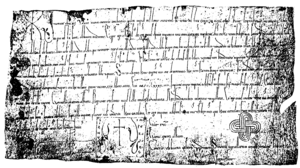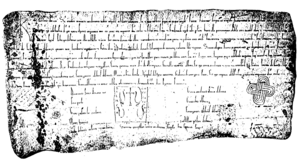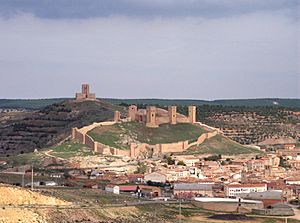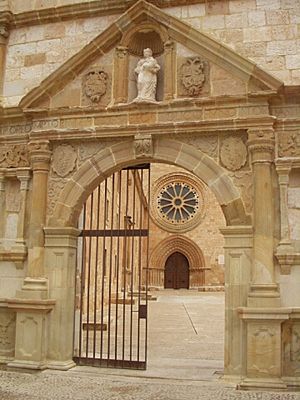Manrique Pérez de Lara facts for kids
Manrique Pérez de Lara (died 1164) was a very important nobleman in the Kingdom of Castile. He was a top leader and general for three kings: Alfonso VII, Sancho III, and Alfonso VIII. From 1158 until his death, he also served as the kingdom's regent, meaning he ruled for the young King Alfonso VIII.
Contents
Manrique's Family and Early Life
Manrique's father was Pedro González de Lara. He was a powerful count who ruled his lands for many years. People at the time said Manrique was just like his father. Even when he was young, Manrique was respected by the king. He was known for upholding laws and fighting against the Moors (Muslims) during the Reconquista.
Manrique's mother was named Eva. Her family background is not fully known, but her name and Manrique's name suggest they might have come from north of the Pyrenees mountains. Manrique had three full brothers: Álvaro, Nuño, and Rodrigo. He also had half-siblings from his parents' previous marriages.
Becoming a Count and Governor (1145–1158)
From 1134 to 1137, Manrique was the alférez for King Alfonso VII. This was a job for young noblemen who were expected to have great careers. It meant he was the head of the king's military household.
In 1143, Manrique was given control of the town of Atienza. This was called a tenencia, which was like governing a region for the king. The next year, he also gained control of Ávila, Madrid, and Toledo.
On August 21, 1145, King Alfonso VII made Manrique a count. This was the highest rank a nobleman could achieve in the kingdom. Even though his father was a count, Manrique had to wait 15 years to get this title from the king himself.
Manrique continued to govern Atienza and Toledo. In 1146, he also received the tenencia of Medinaceli. That same year, King Alfonso sent Manrique and other leaders to help a Muslim ally regain the cities of Baeza, Jaén, and Úbeda. They succeeded, but then they had a disagreement with their ally and fought him.
In January 1147, Manrique played a key role in capturing Calatrava. The king recognized his efforts in a special document. In August, Manrique helped take back Almería and its surrounding areas. He was given Baeza as a tenencia right away. A writer from that time praised Manrique for his generosity and leadership. He was seen as a great and giving leader. Manrique governed Baeza for ten years, until 1157. In 1148, he also received the tenencia of Segovia.
Manrique's Household and Family Life
In 1149, Manrique was given an important job: he became the tutor and guardian of the king's oldest son, Sancho III. This meant the future king grew up in Manrique's home. Manrique had a large household, almost like a small court. He had his own military leaders and even a chaplain and a scribe. By 1155, he had a clerk who signed documents as his "chancellor."
Around 1153, Manrique married Ermessinde. She was from a noble family in Narbonne. They had several children: Aimerico, Ermengarda, Guillermo, María, Pedro, and Sancha.
In 1153, Manrique and Ermessinde gave the village of Cobeta to several monasteries and the cathedral of Santa María in Sigüenza. This cathedral was still being built at the time. Manrique might have been the first nobleman in Castile to use a special seal to prove his documents were real. This was a new idea, likely influenced by practices in France.

Laws and Power in Molina
On April 21, 1154, Manrique and Ermessinde gave a special set of laws, called a fuero, to the town of Molina de Aragón. This document listed the rights of the people, the taxes they owed, and how the town council would work. It also included many laws about how the local army (militia) should be formed. Knights who lived in the town were excused from taxes. A part of any treasure taken in war by the local militia went to Manrique.
The fuero also said that people with a certain amount of wealth had to buy a horse and serve as a knight in the militia. Manrique's rule in Molina was almost like that of an independent ruler. He even used the phrase "count by the grace of God," suggesting his power came from God, not just the king.
In 1155, Manrique bought the village of Alcolea for a large sum of money, showing how wealthy he was. In 1156, the king gave Manrique a special right. Because of urgent needs to protect the area from the Almohads (a Muslim group), Manrique was allowed to give away royal land to his supporters in the Baeza region. He could do this using his own scribe and seal, without needing the king's court to approve every time.
In 1156, Manrique was also given control of Burgo de Osma. He then appointed his own vassal (a loyal follower) to govern it for him. In 1157, the cities of Almería and Baeza were lost to the Almohads. King Alfonso VII died in August of that year.
Regent of Castile (1158–1164)
After King Alfonso VII died, his kingdom was divided between his two sons. Sancho became king of Castile, and Ferdinand became king of León. When King Sancho III died on August 31, 1158, his son Alfonso VIII was still a child. Manrique became the regent and guardian of the young King Alfonso VIII. This meant Manrique was in charge of the kingdom until Alfonso was old enough to rule.
There was a big fight over who would be the guardian of the young king. The Lara family, led by Manrique, forced the Castro family into exile, which started a civil war. In March 1160, the exiled Castro leader, Fernando Rodríguez, returned and fought the Laras in the Battle of Lobregal. The Castros won, and Manrique's brother Nuño was captured.
By March 1161, Manrique was officially called the "nurturer of the king" and "manager over the affairs of the kingdom." In 1162, Manrique lost control of Atienza and Toledo, but he was given control of San Esteban de Gormaz.
Manrique was killed by Fernando Rodríguez of the Castro family in the Battle of Huete in 1164. The exact date of the battle is debated, but it was likely in early June or July. Manrique was buried in the Cistercian abbey of Santa María de Huerta. His wife, Ermessinde, continued to live until at least 1175. She made many donations to churches and monasteries.
| Preceded by Ramiro Fróilaz |
Alférez del rey 1134–1137 |
Succeeded by Diego Fróilaz |
See also
 In Spanish: Manrique Pérez de Lara para niños
In Spanish: Manrique Pérez de Lara para niños





